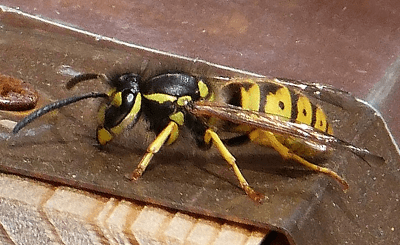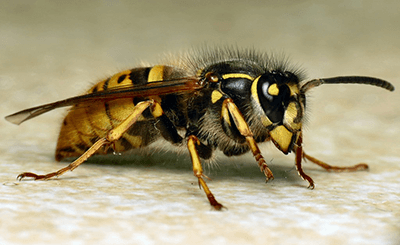Wasp Removal Leeds
Fixed price wasp nest treatment £60
Wasp Removal Leeds specialise in Wasp nest treatment in Leeds and the surrounding area of West Yorkshire. All our WASP removal work is guaranteed and we undertake both domestic and commercial work
Servicing: The Leeds, Bradford, Castleford, Wakefield, Huddersfield, Halifax, Pontefract, Normanton, Rothwell, Batley, Heckmondwike, Cleckheaton, Brighouse, Pudsey, Horsforth, Shipley, Yeadon, Guiseley, Kippax, Garforth, Horbury, Morley, Tingley, Alwoodley and Crossgates areas.
Contact THS Pest Control
Tel: 0113 285 4505
Mob: 07904 189 445
Fast reliable same day service, all work guaranteed, all aspects of pest control covered.
The 2 most common wasps that the causes the public concern in the summer months are:-
The German Wasp – Vespula Germanica

German Wasps are usually found in holes in the ground or Bushes.
The Common Wasp Vespula Vulgaris

Common Wasps can be found inhabiting man-made structures houses or sheds etc.
At THS Wasp Removal we employ various methods for the control /removal of Wasp Nests, all of which are carried out safely and appropriately by professional Wasp Nest experts.
Our Wasp nest removal Cost is a fixed fee of £60 for any Wasp Nest in any Location, all work is guaranteed and there are no hidden extras.
Life Cycle of a Wasp
A Queen Wasp will leave its winter home (a small golf ball size nest) in the early spring months, and look for another location to start building this year’s Wasp Nest.
The Wasp Nest is made of chewed vegetation and Wasp Saliva to form a Pape Mache structure, with layers of hexagonal cells (similar to a Bees honeycomb). Within the hexagonal cells the queen lays an egg, which in turn changes from egg to Wasp Grub, from Wasp Grub to Pupa and then from Pupa to Wasp.
The Wasp’s spend their time bringing food (insects) and building material back to the Wasp Nest ensuring the continuous growth of the Wasp population and the size of the Wasp Nest.
The average Wasp’s Nest will have on average 5000 Wasp’s, but in hotter summers it is not uncommon for larger Wasp Nests to house over 10,000 Wasp’s.
Wasp’s will protect their territory ferociously, so any intruder will be in danger of receiving numerus Wasp Stings, because unlike Bees, Wasps can sting more than once. Wasp’s become more aggressive in early autumn, and it is thought once contributing factor to this is that the Wasp’s become drunk on fermenting fallen fruit from Apple Trees, Plums etc.
Once the temperature starts to drop in late October early November, the worker Wasp’s die and the Queen leaves the nest, the Wasp nest is then redundant and will not be used again. Any large Wasp Nest’s found in roof spaces in the early part of the year can just be knocked off the rafter etc. and thrown in the bin. The queen is the only survivor and builds another small nest in which to hibernate until spring. The process then starts again the following early spring.